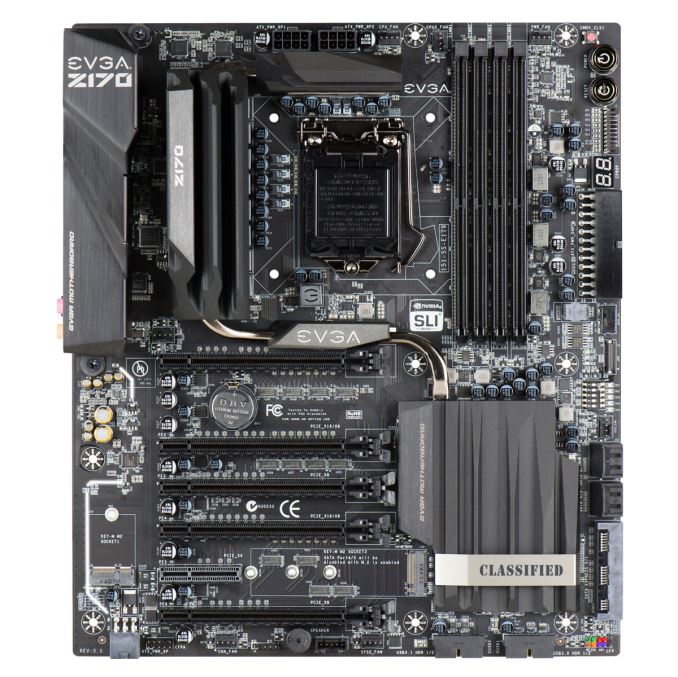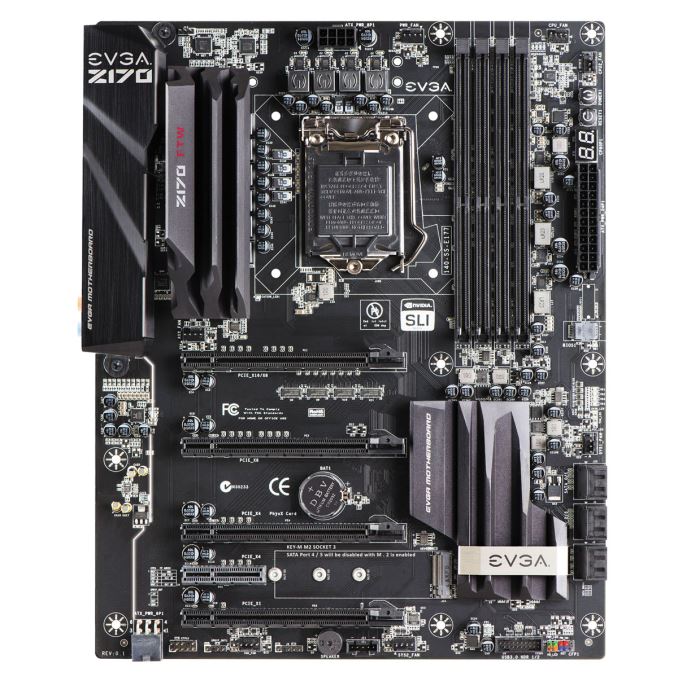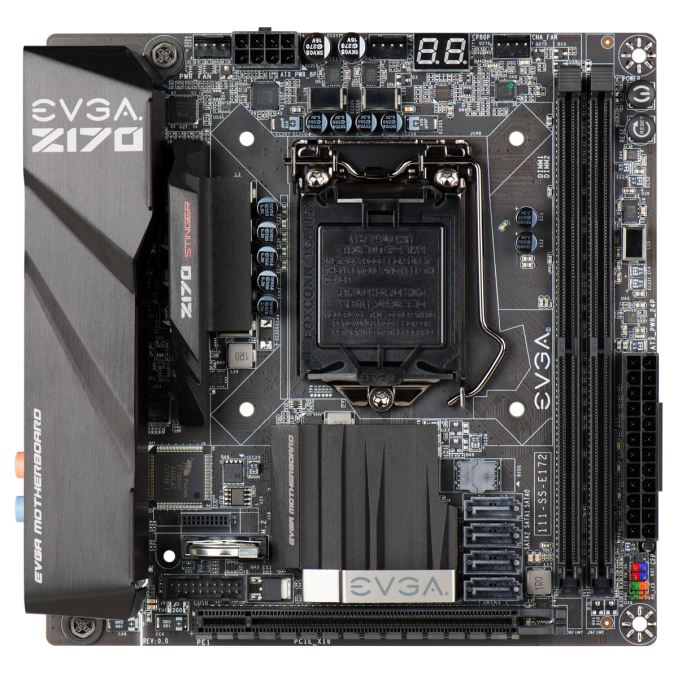Intel Skylake Z170 Motherboards: A Quick Look at 55+ New Products
by Ian Cutress on August 5, 2015 7:59 AM ESTEVGA Z170
Over the past few generations of EVGA motherboards, one of the goals has been to emulate the success they achieved during the X58 motherboard era. At that time, the motherboards were highly praised for their overclocking prowess for what was (and still is) a relatively small motherboard manufacturer. EVGA’s historic strengths lie in their legions of fans and a typical expectation that in most of their big markets, they will field the warranty issues rather than the retailer. Z170, like the others, brings on the EVGA wind in the three regular segments.
EVGA Z170 Classified
Aimed at the pure high end, the EVGA Classified might be the most expensive Z170 board on the market. Here they have used a single PLX 8747 chip under that middle heatsink to provide x8/x8/x8/x8 bandwidth to the PCIe slots. Using a PLX 8747 chip on a mid-range motherboard is not new, it was all the rage back in Z77, but what makes it different here is that the company that manufactures the chip has changed hands and now focuses on the enterprise market. As a result, the costs of such a chip are seemingly doubled overnight, making it an unenticing prospect for the consumer market. Nonetheless, EVGA is aiming for an overclocking motherboard with Quad-SLI support and here it is.
Alongside the extensive heatsink configuration to aid both the power delivery and that PLX chip, EVGA equips the board with dual network controllers (I219-V and I210-AT), a Creative Sound Core3D audio solution, two USB 3.1-A ports on the rear panel, an M.2 slot running in PCIe 3.0 x4 mode, seven 4-pin PWM fan headers, triple BIOS support, EZ voltage read points and the onboard readout will output the temperature when in the operating system.
EVGA Z170 FTW
The FTW follows a similar design pattern to the classified in terms of hardware layout, but reduces it all down into a more cost effective market. As a result the PLX chip is gone, the power delivery heatsink arrangement is reduced, a number of the OC features are lifted off and other connectivity is reduced. The single network port is an Intel I219-V, there is no USB 3.1 and we have the base six SATA ports from the chipset. We still keep the M.2 based off of the PCIe 3.0 x4 bandwidth, but the PCIe slots only support up to x8/x4/x4 with the final slot being an x1. This seems a little odd, given how many PICe lanes the chipset can use.
EVGA Z170 Stinger
The Stinger is the mini-ITX solution, keeping the line alive after several generations. Taking on board previous comments, the power connectors are now on the outside of the DRAM slots or at the top of the motherboard, along with the important front panel connectors. There seems to be enough space around the CPU slot for larger air coolers, although the SATA connector placement will be a nightmare when locking cables and large PCIe cards are used. EVGA does list the Stinger as having a 10-layer PCB, which might make it one of the mini-ITX motherboards with the most layers, although this just makes the design of the board easier and pushes up cost. Similar to the FTW, we don’t get USB 3.1 on this model with only an Intel I219-V network port and Realtek audio.













85 Comments
View All Comments
stylinred - Thursday, December 24, 2015 - link
I have the mATX board, i like it! my only issues are:The pcie x16 is too close to the cpu, when using air cooling, and something large like the Noctua 15, the radiator fins sit right up against the GPU.
When using the Pci-e x16, the pci-e x1 is blocked and the Sata connections are blocked by GPU's so be sure to install your sata devices first
ParimalV - Wednesday, February 3, 2016 - link
I am confused that which of these motherboards have illuminated msi branding on the heatsink like asus rog motherboards have that eyes which can glow on heatsinkgsuburban - Friday, February 5, 2016 - link
Not enough SATA 3 ports, only 4, and no display port ?mathiash - Sunday, June 26, 2016 - link
Asrock should always get extra stability tests, especially their ITX boards. People are reporting nothing but trouble with these.gsuburban - Saturday, July 16, 2016 - link
My only beef with the new M.2 tech motherboards is; when using an M.2 drive, it disables a SATA 3 port. On some other brands, one M.2 drive will disable 2 SATA 3 ports. Either the chipset or the board designers need to configure to allow all ports to function. Many users, have several HDD's for storing their documents (user account) on them vs. on the M.2 plus back up needs such as images and file backups.I'm still wondering why the current boards bother with the 15-D video connector and why some don't use an HDMI video port while opting for the display port. HDMI is the future for anyone who will be looking for BluRay full audio functionality and HDMI is the only interface that supports it via the HDMI v2.0 and HDCP v2.2